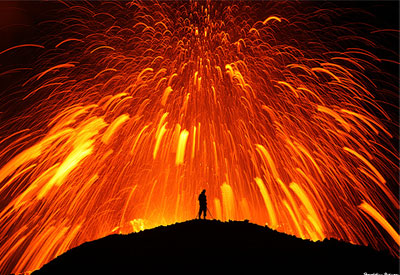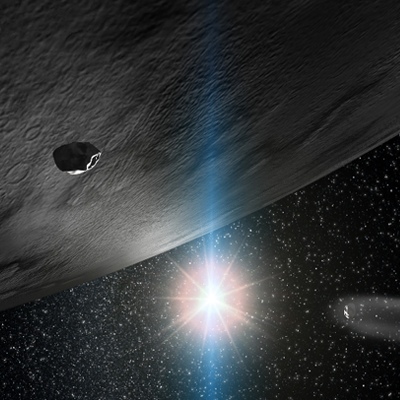 It’s Friday again and that means time for another Science Friday! This week, see the best images of the unpronounceable Icelandic volcano, see what happens when a space balloon launch goes wrong, watch amazing videos of the latest solar activity, ponder if life came from asteroids, and learn how to make Mars sample return possible. All this and more plus our gadget of the week.
It’s Friday again and that means time for another Science Friday! This week, see the best images of the unpronounceable Icelandic volcano, see what happens when a space balloon launch goes wrong, watch amazing videos of the latest solar activity, ponder if life came from asteroids, and learn how to make Mars sample return possible. All this and more plus our gadget of the week.
Best Images from Eyjafjallajokull Eruption
News has been abuzz for the last couple of weeks about the Eyjafjallajokull eruption in Iceland. One reason for its large public impact is the fact that its ash cloud disrupted air traffic for several days across Western Europe. But, geologists have been very excited at the chance to observe such an explosive volcano up close during the eruption. Lots of scientists found their way onto the ice, and they brought their cameras with them. There are a lot of “Best of” albums full of Eyjafjallajokull images out there, but the flickr album put together by Yahoo! Editorials really stands out. Check out the gallery on flickr.
Interested in learning more about how scientists study volcanoes? If you live in or near Vancouver, WA, head over to the USGS Cascades Volcano Observatory on Saturday, May 8th for the FREE public open house! More details in the event flyer (PDF).

Lava River by orvaratli

Playing with the Devil by skarpi
Space Balloon Launch Goes Wrong: Flips SUV, Barely Misses Bystanders
The launch of a multi-million pound space balloon went awry in the Australian outback, when stronger than expected winds broke the balloon and its payload free from a crane holding it down as it filled with air. At the time of the crash the car-sized balloon, part of a research project by academics and students at the University of California, Berkeley, and several Taiwanese universities, was believed to be carrying a rare telescope, valued at between $5 million and $10 million, that monitors gamma rays. A camera crew at the launch site caught the event on tape as it over turned an SUV and narrowly missed bystanders. Luckily, no one was hurt in the accident.
Massive Eruption, Scorching Rain Seen on the Sun
The Solar Dynamics Observatory (SDO), which was launched by NASA in February of 2010, has been taking new high resolution images and videos of our sun. The spacecraft is designed to help us understand the Sun’s influence on Earth and Near-Earth space by studying the solar atmosphere on small scales of space and time and in many wavelengths simultaneously. Lately SDO has been on a roll, binging us new amazing imagery of solar prominences and flares. Just this week, the SDO team released one of the most amazing videos yet, which shows a massive solar eruption and red hot solar rain. The massive solar eruption is one of the biggest in years. The movie, recorded on April 19th, spans four hours of actual time and more than 100,000 km of linear space. Our humble planet Earth could fit in between the plasma streamers with room to spare. Check out the videos below! The second is color coded for temperature. Coronal rain turns out to be relatively cool—”only” 60,000 K. When the rains falls, it is supported, in part, by an underlying cushion of much hotter material, between 1,000,000 and 2,200,000 K.
Interested in learning more about solar phenomena? Check out a recent article on ScienceDaily: Magnetic ‘Ropes’ Tie Down Solar Eruptions.
Red and oranges are cool (60,000 K – 80,000 K); blues and greens are hot (1,000,000 – 2,200,000 K). The black “hair-like object” is a speck of dust on the CCD camera.
NASA Studies Ways to Save on Mars Sample Return
The ultimate goal in robotic exploration of Mars is to bring a piece of the red planet home to be studied on Earth. But, a sample return mission would be costly. It is expensive enough to land on Mars safely, but to blast off again and come home requires a lot of extra fuel, and a lot of extra cost. Because NASA’s budget is so limited, they are now studying ways to make the trip less expensive by breaking a sample return mission into three phases. t may be possible to break down the complicated and expensive mission into three parts, said Steve Squyres, a Cornell University astronomer who leads the Mars Exploration Rover Mission. “It makes the program more affordable because it strings out the cost over time,” Squyres told reporters in a telephone briefing. “It brings down the cost per year of doing such a thing.” He described a “hellish” mission in which a robot, similar to the successful Spirit and Opportunity rovers, scoops up a sample from the Martian surface. The next mission would be a lander that would plop down beside it, Squyres said. This vehicle could sling the sample into orbit around Mars, waiting for a third mission to retrieve it and bring it to Earth for study.

Concept drawing of a Mars sample return mission
Asteroid Ice Discovery Suggests Earth’s Water Came From Space
For the first time, water ice and organic molecules have been discovered on the surface of an asteroid. The finding was reported this week in Nature from two teams of scientists who worked independently, and the conclusions are based on analyses of bouncing infrared light off of 24 Themis, a large asteroid between Mars and Jupiter. The new evidence supports the possibility that the essential building blocks of life on Earth (both water and organic molecules) came from asteroids.
Read More at wired.com.

Concept drawing of 24 Themis – did building blocks of life come from asteroids?
Gadget of the Week: Make Your Own Compressed Air Rocket
From the people of Make: magazine comes a new weekend project that won’t set you back much money and that is easy to do on your own! Their video highlights how to send a 25cent rocket hundreds of feet in the air with some PVC pipe, a sprinkler head, and a bike pump. Check it out! (more at Make:)
#FollowFriday
If you are on Twitter, you know there are plenty of amazing people out there tweeting away. And, many of them are scientists! Every Friday I’ll be bringing you a new list of great scientists and techies to follow on Twitter. This week…
- @TrekJen: Gamer, snowboarder, Trekhead, lazy bum, fingernail biter, coffee and zombie addict. Run TrekSpace.org Trek your ass over and visit us!
- @volcanotweet: Updates on volcanic activity from around the world and the latest in volcanic research.
- @Voyager2: Official Twitter of the NASA spacecraft Voyager 2
Science Quickies
Not enough science for you? Here’s a warp-speed look at some more science tid-bits that are worth a look.
- World’s biggest telescope to be built in Chile
- Physicists locate long lost Soviet reflector on the moon
- Scientist proposes ‘laser tractor beam‘ to clean up space junk
TrekMovie’s Science Friday is an homage the the great NPR radio show Science Friday. Science Friday® is a registered service mark of ScienceFriday Inc.

Some beautiful pictures from the sun. Very nice indeed.
Those are some fantastic Pics from the iceland Volcano. and the Sun. Loomks like somebody needs to teach Nasa in the Outback on how to Blast Off!!!.
– By Crom! That Icelandic hothead ItchyOffJollySkull be quite mad! And madder still be any man ta’ stand next ta’ such a “vulcan”ized blowhard!
– I guess me umbrella be no good in tha’ solar rain? I made it outta’ asbestos though.
Now, wit’ apologies ta’ Sinatra:
“The solar wind
Came blowin’ in, from across the sun’s sea
It lingered there, singed my hair- to firewalk with me
All solar long, we sang a song, and strolled on the molten lands
Two sweethearts… and the the plasma bands.”
Anyone got some Noxema?
– Poor Aussies! But a balloon? Did Captain Kangeroo o’ NASAF (Near-drunk Aussies Shootin’ Fosters) give this a go? Actually, it’s terrible that they lost thar’ gamma-radiation telescope. How will theys ever find tha’ Hulk now?
Oh- I only kidz cuz’ I luvs. Hope they have tha’ fundin’ ta’ try, try again, but next time wit’ no wind. Consult a meteorologist… or some other voodoo practitioner…
Oh, and I am court ordered to not build any more model rockets. Ye’ burn down one Wal-Mart and they ne’er forgive!
Science!!!!!!! It be grand!
Arrrrrrrrrrrrrrrrrrrrrrrrrrrrrrrrrrrrrrrrrrrrrrrrrrrrrrrrrrrrrrrrrrrrrrrrrrrrrrrrrrrrrrrrrrrrrrrrrrrrrrrrrrrrrrrrrrrrrrrrrrrrrrrrrrrrrrrrrrrrrrrrrrrrrrrrrrrrrrrrrrrrrrrrrrrrrrrrrrrrrrrrrrrrr…
I half expected Voyager to come sailing through that Solar activity!
And you have to feel for those poor guys behind the Space Balloon experiment. So much effort must have gone in to have it wrecked by a gust of wind.
All good stuff on here- as always. Thanks!
Yep, the solar thing is very nice what i will like to knows is is this real time or a few hours compress in 30 seconds ?
Kayla:
I get no link on the Flickr volcano photos.
flickr link fixed
Such a good article, guys, love it.
Those are some amazing pictures of the eruption and of the sun.
TGIF!!!!
Man – that has to be one seriously HEAVY balloon.
Oh – wait. Not THOSE pounds, but THOSE pounds.
Nevermind.
“Asteroid Ice Discovery Suggests Earth’s Water Came From Space” Or just that there is ice on that asteroid. And since everything Earth consists of comes from and is part of space…
“Physicists locate long lost Soviet reflector on the moon” Just took them 40 years. Quite absent-minded those scientists.
“Scientist proposes ‘laser tractor beam‘ to clean up space junk” Thats not recycling. Just grab a trash bag, collect it and bring it to the nearest recycling center, like everybody else.
At least Trek writers know how to make up names you can pronounce…
9- actually , I believe it is THOSE pounds
see, we use dollars in australia too
so yes, that is one very heavy balloon
And then there’s this cool story from yahoo news!
Let’s go skiing, the snow looks great!
http://news.yahoo.com/s/space/20100430/sc_space/giantblizzardragingonsaturn
@# 5. TrekDude: The thirty seconds of video represents about 4 and a half hours of real time. Check out http://www.badastronomy.com – Dr. Phil Plait often posts such stuff, accompanied by explanations. Quite a good read :)
Re: heavy balloon. That is the weight of the payload, so the balloon is VERY light in order to counteract that!